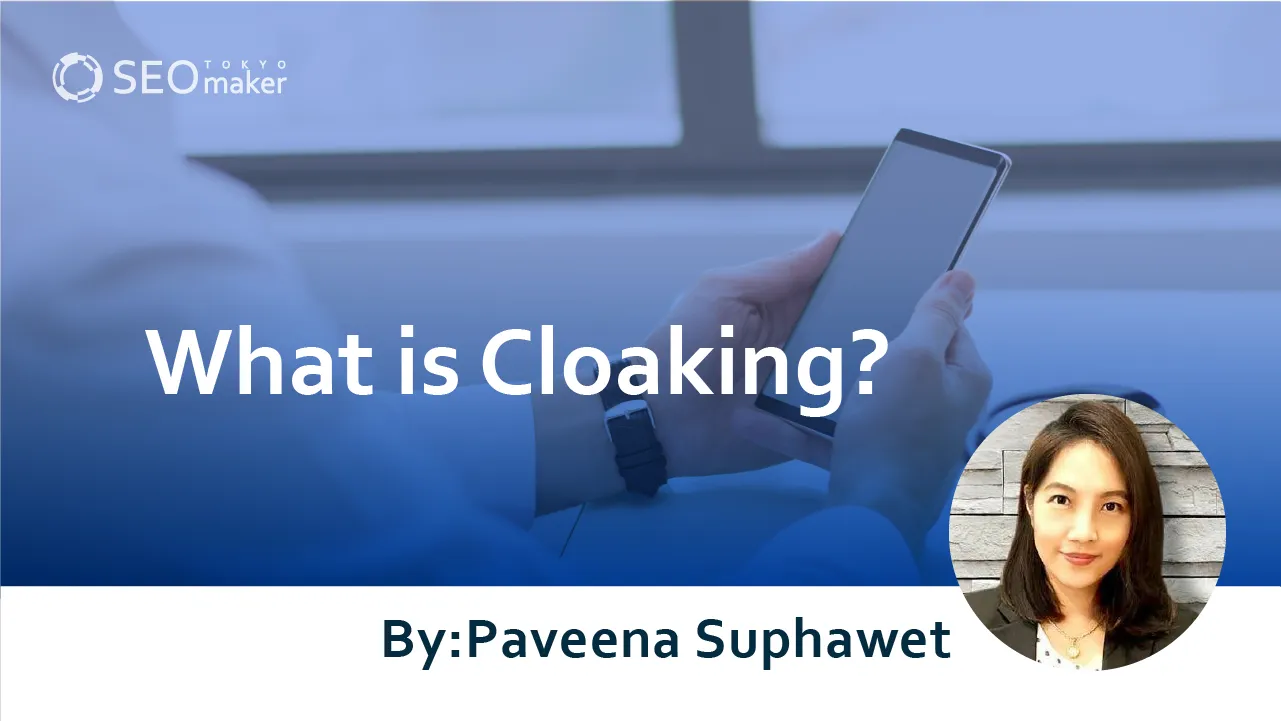What is Cloaking? The Impact on SEO and How to Counteract It
contents
 Cloaking is a technique where the content displayed is different for search engine crawlers and for users. Previously, it was also known as stealth or phantom. Cloaking is considered deceptive because it artificially boosts search engine rankings, which can lead to a reduction in usability.
Cloaking is a technique where the content displayed is different for search engine crawlers and for users. Previously, it was also known as stealth or phantom. Cloaking is considered deceptive because it artificially boosts search engine rankings, which can lead to a reduction in usability.
Additionally, cloaking might be carried out by hackers without the site owner’s knowledge.
Websites that engage in cloaking can negatively impact SEO, leading to lower search rankings or even being removed from search results altogether. These penalties can apply even if the cloaking was done by hackers, making prevention essential.
As SEO consultants, we provide strategies to counter unintentional cloaking and introduce tools that can detect cloaking.
What is Cloaking?
Cloaking is a technique where different content is shown to users and search engine crawlers, aimed at enhancing site evaluation from search engines. It’s considered a form of spamming, and websites engaging in cloaking may face penalties.
Reasons for Cloaking
From an SEO perspective, websites with a high keyword density or simple HTML structures are often favored. In contrast, sites that use many images or FLASH might not be rated as highly, though they are visually appealing and have a creative design.
Some operators have used cloaking to bridge this gap, attempting to gain favorable evaluations from search engines.
Furthermore, illegal adult sites often employ cloaking. They present themselves as legal video sites to crawlers while showing illegal content to users when they access the site. This allows them to attract traffic while avoiding penalties for handling illegal content.
However, cloaking is an unfair practice and not a legitimate SEO strategy. Presenting different information to users than what is provided to Google contradicts the principles of SEO and can undermine trust in Google among users.
Negative Impact of Cloaking on SEO
Cloaking has detrimental effects on SEO, specifically
- Lowering search rankings
- Removal from search results
Google officially states that cloaking violates its guidelines.
Cloaking involves displaying different content or URLs to human users and search engines. It leads to unexpected results for Google users, thus violating Google’s Webmaster Guidelines (Quality Guidelines).
Source: Cloaking (Google Search Central)
Engaging in cloaking to improve search engine evaluation is dishonest and should never be practiced.
Exceptions to Cloaking
While cloaking generally has a negative connotation, there are exceptions that are considered acceptable. Here are three common examples.
- Providing separate sites for smartphones.
- Displaying different content based on the time of day accessed.
- Showing different content depending on the geographic location of access.
What these three examples have in common is that they all provide content beneficial to users. Offering the right content based on the user’s device, time, or location of access is advantageous for users.
Always prioritize delivering the most appropriate content for users accessing your site, rather than for the site’s convenience.
Methods of Cloaking
There are mainly two methods of cloaking
- Hidden text
- Redirecting non-crawlers
The methods listed here should not be implemented. They are mentioned for informational purposes only.
Hidden Text
Hidden text involves making text visually difficult to detect. There are five main techniques.
- Using white text on a white background
- Placing text behind an image
- Using CSS to position text off-screen
- Setting the font size to zero
- Hiding a link within a single small character (like a hyphen in a paragraph)
Source: Hidden Text and Hidden Links (Google Search Central)
Using these methods, it is possible to make keywords recognizable only to crawlers and not to users. In the past, hidden text was used as an SEO strategy to aim for higher search rankings by embedding keywords covertly within a site.
Currently, using hidden text can be considered deceptive and may violate Google’s Webmaster Guidelines (Quality Guidelines). Therefore, SEO tactics involving hidden text are ineffective and should be avoided.
Redirecting Non-Crawlers
This method is often used in hacking to generate revenue. Hackers infiltrate a targeted website and redirect everyone except Google’s crawlers to a different site. This results in cloaking without the site operator’s awareness.
If left unchecked, this can lead to penalties, resulting in lower search rankings or removal from search results. Cloaking due to hacking can be countered with specific tools, which will be discussed later.
Specific Examples of Cloaking
There are primarily two types of cloaking.
- Displaying different content to crawlers and humans.
- Using images or FLASH.
When displaying different content based on whether the visitor is a human or a crawler, the distinction is usually made using IP addresses or user agents. This technique shows completely different content to search engines and users, commonly seen on illegal adult sites.
Another example is presenting a stylish and image-heavy site to users while showing a text-only simple HTML structure to search engines. This method is often used as an SEO tactic.
Even if cloaking is used as an SEO strategy, it still violates Google’s guidelines. If you are using such methods for SEO, it is advisable to stop immediately.
Avoiding Unintentional Cloaking
Whether intentional or not, cloaking is considered deceptive. There are three ways to ensure you are not mistakenly engaging in cloaking
- Distributing crawlers between smartphones and PCs.
- Blocking crawlers from content that is only visible after logging in.
- Checking for hacking.
Distributing Crawlers Between Smartphones and PCs
When displaying different content for smartphones and PCs, ensure crawlers are appropriately distributed. Google uses different crawlers for smartphones and PCs
- Smartphone Crawler: Googlebot Smartphone
- PC Crawler: Googlebot Desktop
If a crawler intended for PC sites is shown the smartphone site, it could be considered cloaking, and vice versa. However, this issue does not apply to responsive websites.
Blocking Crawlers from Content Visible Only After Logging In
Pages that require login, such as those on e-commerce or membership sites, typically do not appear in search results. However, setting them to appear in search results can be seen as cloaking.
This happens because the crawler might see the pages available after logging in (like product details or member-only content), while users only see the login page.
To avoid this, block crawlers from accessing pages that are only visible after logging in, ensuring they do not appear in search results.
Cloaking as a result of hacking is particularly problematic because it can happen without your knowledge and intent, and it may result in penalties. Therefore, it’s crucial to check if your site has been compromised by hackers.
When checking, the URL Inspection Tool in Google Search Console is useful. By entering your site’s URL, you can verify if it is correctly indexed.
Additionally, implementing security plugins and two-factor authentication can help prevent hacking. If multiple users can access the site internally, ensure settings allow for automatic logout.
Measures for Unintended Cloaking
If you discover unintended cloaking, there are three methods to address it
- Remove the affected page.
- Use noindex.
- Utilize tools.
Removing the page where cloaking has occurred is the simplest method, but it may not be suitable for pages that cannot be deleted due to certain circumstances. In such cases, you can use noindex in the html head tag.
Please insert <meta name=”robots” content=”noindex”> within the head tag.
<head>
<meta name=”robots” content=”noindex”>
</head>
The purpose of noindex is to prevent crawlers from displaying the site in search results, although it does not block the crawler from visiting the site.
If you are using WordPress to create and manage your site, installing a plugin can easily set up noindex.
Tools to Detect Cloaking
Here are four tools that can be used to detect cloaking, selected from both free and paid options
- Highly Rated
- SEARCH WRITE
- SEO Pack
- Google Search Console
When using tools, there are options available for free and others that are paid.
Highly Rated
Highly Rated is a tool provided by GMO and is available for free. It displays basic information about the page and checks if keywords are used appropriately, offering a clear view of basic SEO performance.
Note that pages built with Ajax or ASP might not have their information retrieved, and URLs that are redirected or modified by JavaScript may also fail to deliver results.
SEARCH WRITE
SEARCH WRITE is a tool provided by PRAN-B Corporation. It automatically checks the internal structure of websites and pages, pointing out areas for improvement and specifying what content is needed. Even those without confidence in their SEO knowledge can use it with ease.
The cost is 50,000 yen per month, which includes no initial registration or setup fees. You can register 1 to 3 sites, and the license number is unlimited. Requests for materials or downloads are free, and you can also sign up for a free demo to experience how it works firsthand.
SEO Pack
SEO Pack is a tool offered by Devo Corporation. It allows for both internal and external SEO measures. If there are issues within the pages, it will provide correction points and also has features to support content creation. Contract plans are available in 3-month and 6-month options.
Google Search Console
Google Search Console is a free tool provided by Google. It allows you to check for issues from the “Manual Actions” menu within the console. Sites with problems like spam activities or cloaking may have manual actions taken by Google staff, and there are two types of actions.
- Site-wide match
- Partial match
If an action affects the entire site, the reasons and targets will be displayed under the site-wide match section. If it affects individual URLs or parts of the site, they will be shown under the partial match section.
Always check the “Manual Actions” page, and if any issues are found, address them promptly.
Summary
Cloaking is a deceptive practice that displays different content to crawlers and users. It was used by some operators to artificially boost search engine ratings, but it is now officially considered illegal by Google and subject to penalties. Cloaking has been primarily used on illegal adult sites but also on sites heavily using FLASH and images. From an SEO perspective, simple HTML structures that are text-focused are preferred, so methods to present such a structure to crawlers have been employed. To avoid cloaking, it’s effective to distribute crawlers between smartphones and PCs, and to block crawlers from pages that are invisible without logging in. Additionally, since unauthorized cloaking can also occur due to hacking, it’s crucial to use tools to regularly check for hacking. If unintended cloaking is discovered, removing the affected page or using noindex to prevent it from appearing in search results can mitigate the issue. Regular site checks with tools can also be a preventative measure.










![What is a Description? Explaining the Meaning, Writing Style, and Changing Word Count – [2023 Edition]](https://www.switchitmaker2.com/en/wp-content/uploads/2024/09/what-is-description.webp)










